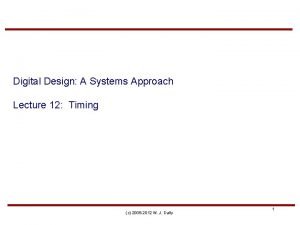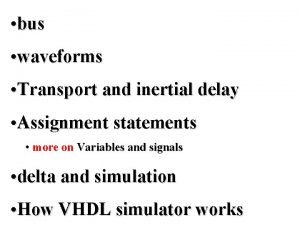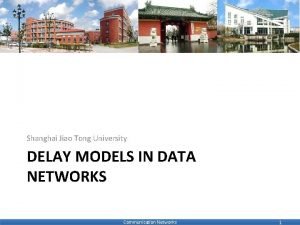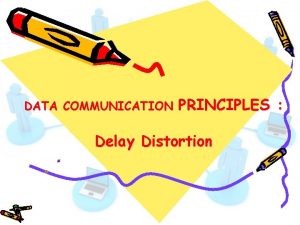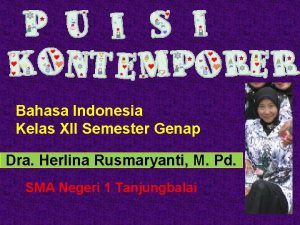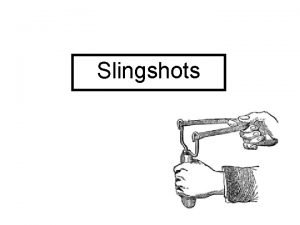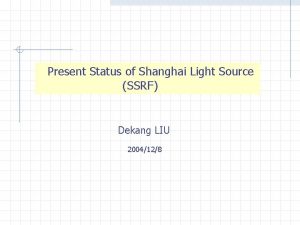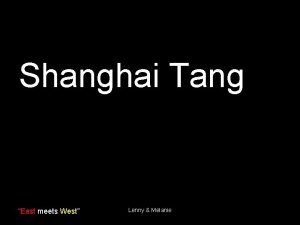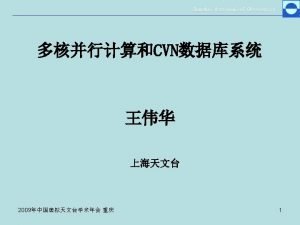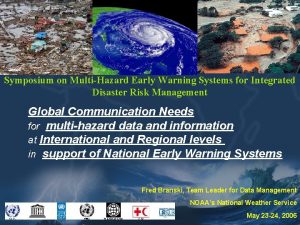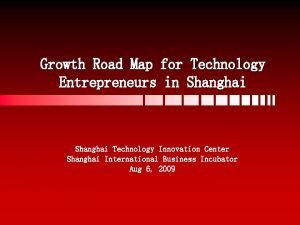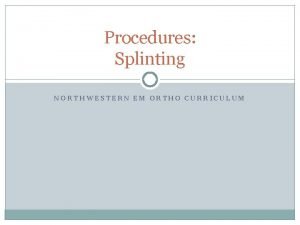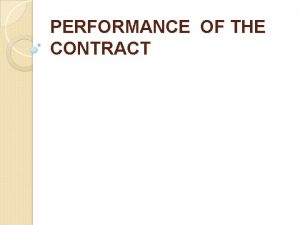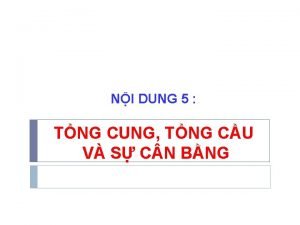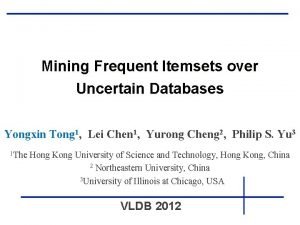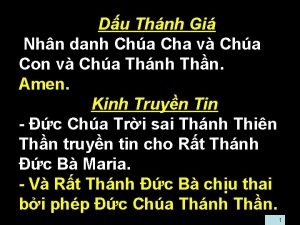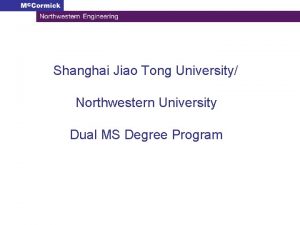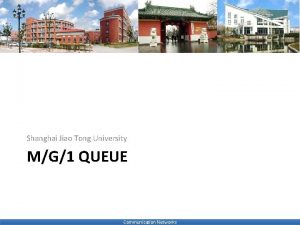Shanghai Jiao Tong University DELAY MODELS IN DATA





























































- Slides: 61

Shanghai Jiao Tong University DELAY MODELS IN DATA NETWORKS Communication Networks 1

Data Networks and Queueing R R R R S Communication Networks 2

Queueing Analysis • We are given: – Packet arrival behavior – Packet length distribution – Packet routing / handling policies • We want to deduce: – Packet delay – Queue length – Packet loss • Queueing theory can also be applied in other areas, such as in analyzing Circuit Switched Network Communication Networks 3

In this Chapter • • • Little’s Law Poisson process M/M/x Queueing systems Burke’s Theorem and Jackson’s Theorem M/G/1 Reservation systems and priority queue Communication Networks 4

Shanghai Jiao Tong University LITTLE’S LAW Communication Networks 5

Little’s Law • Named after John Little, an MIT Sloan professor Little J. D. C. “A proof of the Queueing Formula L= λw, ” Operation Research, 9, 383 -387 (1961) Communication Networks 6

About Little’s Law • The result is very useful because of its generality – System should be stationary – Without any other assumptions • • Arrival process can be anything Treat system as a black box Can be applied to whole system or Any part of the system • It can naturally explain why stationary – On rainy days, traffic moves slower and the streets are more crowded – A fast-food restaurant needs a smaller waiting room Communication Networks 7

Observation 1 Communication Networks 8

Observation 2 Communication Networks 9

Proof • Communication Networks 10

Application: Transmission System queue transmitter transmission line Communication Networks 11

Communication Networks 12

Solution Communication Networks 13

Application to a Complex System λ 3 λ 1 λ 2 R R R R λ 1 λ 3 Communication Networks 14

Shanghai Jiao Tong University ARRIVAL MODEL Communication Networks 15

Arrival Process • The arrival process can normally be described – by the number of arrivals in a unit time – or can be described by inter-arrival time • Poisson process – Most commonly used arrival model in telecom network – Named after the French Mathematician Simeon-Denis Poisson (1781 – 1840) Communication Networks 16

Examples of Poisson Process • The number of page requests arriving at a web server (no attack, please) • The number of telephone calls arrives at an switch • The number of photons hitting a photon detector, when lit by a laser • The execution of trades on a stock exchange • … Communication Networks 17

Definition 1 • Communication Networks 18

Definition 2 • • Proof of 1→ 2 Communication Networks 19

Definition 3 • Communication Networks 20

Property 1 Last arrival When is the next arrival? • Communication Networks 21

Proof • Communication Networks 22

Proof of the Analogue • Communication Networks 23

Property 2 • Communication Networks 24

Proof • Communication Networks 25

Property 3 • A Poisson stream can be divided to a set of Poisson streams based on this property Communication Networks 26

Property 4 • PASTA: Poisson Arrival See Time Average – One of the central tools in queueing theory – An arrival customer always see the system in the average state, in terms of the number of customers in the system Si Communication Networks 27

Proof • Communication Networks 28

Example: Suppose that inter-arrival times are independent and uniformly distributed between 2 and 4 seconds, while customer service times are all equal to 1 second. • An arriving customer always finds an empty system • The average number in the system as seen by an outside observer looking at a system at a random time is 1/3 Communication Networks 29

Homework 1 Communication Networks 30

Homework 2 Communication Networks 31

Shanghai Jiao Tong University M/M/X QUEUING MODELS Communication Networks 32

Single Server Queue queue S • M/M/1 (M/M/x) – Poisson arrivals, exponential service times • M/G/1 – Poisson arrivals, general service times – M/D/1: Poisson arrivals, deterministic service time (fixed) Communication Networks 33

Our Goal • Communication Networks 34

M/M/1 Systems • Communication Networks 35

Memoryless Property of M/M/1 Systems • Recall that negative exponential random variables are memoryless, thus Departures Arrivals Communication Networks 36

Behavior of M/M/1 Queues • Departures Arrivals Communication Networks 37

Discrete-Time Markov Chains • Communication Networks 38

• Communication Networks 39

• Communication Networks 40

• Communication Networks 41

Transition Probability of M/M/1 Queues • Communication Networks 42

• Communication Networks 43

Equilibrium Equations • Communication Networks 44

Detailed Balance Equation • Communication Networks 45

Stationary Probability • Communication Networks 46

Major Results of M/M/1 Queues • Communication Networks 47

Communication Networks 48

Stable Condition of M/M/1 Queues • Communication Networks 49

Application: Circuit Switching vs. Packet Switching Packet switching (statistic multiplexing) … • queue Circuit switching (dedicated) … • Communication Networks 50

queue …. Communication Networks 51

• Communication Networks 52

M/M/m Systems • Communication Networks 53

Results • Communication Networks 54

M/M/∞ • Communication Networks 55

M/M/m/m • Communication Networks 56

Results for M/M/m/m Queues • Communication Networks 57

Home Work 3. 11 Communication Networks 58

Home Work 3. 12 Communication Networks 59

Home Work 3. 27 Communication Networks 60

Figure for 3. 27 Communication Networks 61
 2tng
2tng Propagation delay and contamination delay
Propagation delay and contamination delay Assignment statement
Assignment statement Timers in plc
Timers in plc Delay models in data networks
Delay models in data networks The university of shanghai for science and technology
The university of shanghai for science and technology Shanghai university of sports
Shanghai university of sports Delay distortion in data communication
Delay distortion in data communication Modals and semi modals
Modals and semi modals Ni hao mandarin
Ni hao mandarin Xiang jiao ping guo
Xiang jiao ping guo Welcome in mandarin
Welcome in mandarin Openstack summit shanghai
Openstack summit shanghai Shanghai world financial tour eiffel tour petronas
Shanghai world financial tour eiffel tour petronas Zip shanghai
Zip shanghai Puisi luka kakiku
Puisi luka kakiku How to make a shanghai slingshot
How to make a shanghai slingshot Huopin
Huopin Ssrf
Ssrf Modern era arts in the philippines
Modern era arts in the philippines City shop shanghai online
City shop shanghai online Shanghai tang song
Shanghai tang song Shanghai
Shanghai Kampasu
Kampasu Shanghai
Shanghai Fishing in shanghai
Fishing in shanghai Quality control shanghai
Quality control shanghai Bloomberg academy hong kong
Bloomberg academy hong kong Habiter le littoral industrialo-portuaire de shanghai
Habiter le littoral industrialo-portuaire de shanghai Shanghai
Shanghai Shanghai integrated circuit industry
Shanghai integrated circuit industry Hong kong and shanghai banking corporation ap world history
Hong kong and shanghai banking corporation ap world history Shanghai tianqi
Shanghai tianqi Shanghai civil affairs bureau
Shanghai civil affairs bureau Shanghai technology innovation center
Shanghai technology innovation center Yan oi tong tin ka ping secondary school
Yan oi tong tin ka ping secondary school Mdm teresa liew sin tong
Mdm teresa liew sin tong Appeal to authority
Appeal to authority Posterior ankle splint with stirrup
Posterior ankle splint with stirrup Pei du ma ma
Pei du ma ma Ulnar gutter splint
Ulnar gutter splint Little britain daffyd thomas
Little britain daffyd thomas Reverse sugar tong
Reverse sugar tong Lang tong
Lang tong She stood on the balcony tongue twister
She stood on the balcony tongue twister Axit fomic
Axit fomic Tongue twister about animals
Tongue twister about animals Tong ren therapy pdf
Tong ren therapy pdf Chenning tong
Chenning tong Vua lý thánh tông
Vua lý thánh tông Tổng kết vốn từ 151
Tổng kết vốn từ 151 Thoái hóa hem
Thoái hóa hem Công thức bán kính hội tụ
Công thức bán kính hội tụ Tong ah perarakan
Tong ah perarakan Psle results 2013
Psle results 2013 Pei tong primary school uniform
Pei tong primary school uniform Smaakzintuigen
Smaakzintuigen Tong aik v eastern minerals
Tong aik v eastern minerals Https://slidetodoc.com/cc-ngun-m-c-chung-c-im-g/
Https://slidetodoc.com/cc-ngun-m-c-chung-c-im-g/ Yongxin tong
Yongxin tong Tong zintuigen
Tong zintuigen Sang danh duc chua cha
Sang danh duc chua cha

